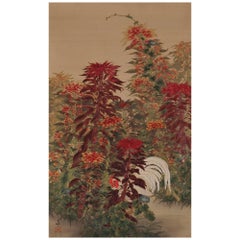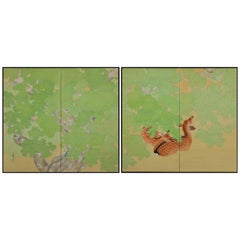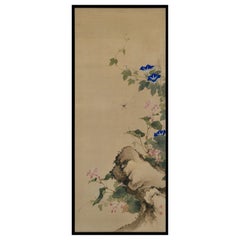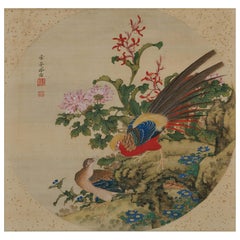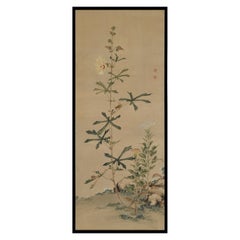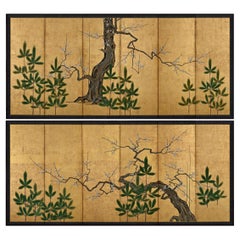Kyoto
to
1,009,826
699,656
29
27
21
19
18
17
9
8
5
5
4
4
3
3
3
1
1
1
1
1
1
1
1
1
1
2
1
Japanese Painting, Hanging Scroll, Circa 1930, Amaranth and Rooster
Located in Kyoto, JP
Amaranth and Rooster
Artist unknown
Hanging scroll, ink, mineral pigment and gofun on silk.
Painting inscription: Tojo ??
Painting seal: Tojo ??
circa 1930
Dimensions:
Scroll:...
Category
Early 20th Century Japanese Taisho Kyoto
Materials
Silk
Early 20th Century Pair of Japanese Folding Screens, Deer Under Maple Trees
Located in Kyoto, JP
Deer under maples
Late Taisho period, circa 1925-1930
Pair of two-panel screens. Ink and pigment on silk.
Signature: Goho
Seal: Goho
A pair of two-fold Japanese silk screens...
Category
1920s Japanese Taisho Vintage Kyoto
Materials
Wood, Paper, Silk
Mid 19th Century Framed Japanese Painting. Spider & Morning Glory.
Located in Kyoto, JP
Obata Tosho (1812-1886)
Spider & Morning Glory
Late Edo period, mid 19th Century
Framed Japanese Painting. Ink and color on paper.
Individually framed 19th century bird and flowe...
Category
Mid-19th Century Japanese Edo Antique Kyoto
Materials
Paper
Japanese Scroll Painting, 19th Century Chinese Pheasants by Yoshizawa Setsuan
Located in Kyoto, JP
Chinese Pheasants
Yoshizawa Setsuan (1809-1889)
Hanging scroll, ink and color on silk.
Painting inscription: Setsuan Houyou
Upper seal: Y...
Category
Mid-19th Century Asian Meiji Antique Kyoto
Materials
Silk
Mid 19th Century Framed Japanese Painting. Grasshopper & Hibiscus.
Located in Kyoto, JP
Obata Tosho (1812-1886)
Grasshopper & Hibiscus.
Late Edo period, mid 19th Century
Framed Japanese Painting. Ink and color on paper.
Individually framed 19th century bird and flow...
Category
Mid-19th Century Japanese Edo Antique Kyoto
Materials
Paper
18th Century Japanese Screen Pair. Plum & Young Pines. Kano School.
Located in Kyoto, JP
Dimensions (Each screen): H. 176 cm x W. 378 cm (69’’ x 149’’)
This pair of Japanese folding screens depict blossoming plum trees amongst young pines. They are designed to capture t...
Category
Late 18th Century Japanese Edo Antique Kyoto
Materials
Gold Leaf
Japanese Painting, Framed Panel, 17th Century Falcon by Mitani Toshuku
By Mitani Toshuku
Located in Kyoto, JP
Mitani Toshuku (1577-1654)
“Falcon”
Wall panel, ink and light color on paper.
Upper seal: Mitani
Lower seal: Toshuku
Dimensions:
Each 118.5 cm x 51 cm x 2 cm (46.5” x 20” x .75”)
Individual falcon paintings by Mitani Toshuku (1577-1654), an early artist of the Unkoku School. Founded by Unkoku Togan (1547–1618), a master of the Momoyama period, the Unkoku school enjoyed long lasting patronage in southern Japan. Togan was a retainer of the Mori family in present day Yamaguchi prefecture. Members of the school considered themselves to be in the artistic lineage of Sesshu Toyo...
Category
Early 17th Century Japanese Edo Antique Kyoto
Materials
Wood, Paper
17th Century Japanese Screen. Karako Asobi: Chinese Children at Play.
Located in Kyoto, JP
Anonymous Kano school artist
17th century
"Karako Asobi: Chinese Children at Play"
A two-panel Japanese Furosaki screen. Ink, pigment, gofun and gold-leaf on paper.
This small Japanese Karako folding screen vividly depicts various games played by children wearing wearing elaborate Chinese T'ang dynasty costumes. They are dressed in plumed and tasseled hats, ornate jackets, baggy pants, and cloth slippers typical of T'ang period Chinese court dress. The children are depicted pulling a younger child along in a cart, carrying another child as if an important official, riding a wooden horse, leading a puppy and carrying a tethered bird. Executed in fine-quality pigments on gold leaf, the detail, variety and size of the figures is noteworthy. Also notable is the size of this screen itself, which denotes it as a Furosaki screen. A Furosaki screen is part of the equipment used for the Japanese tea-ceremony. It is traditionally placed on tatami mats behind the brazier highlighting the utensils and providing a focal point.
Karako is a Japanese term used in art with the depiction of Chinese children playing...
Category
17th Century Edo Antique Kyoto
Materials
Gold Leaf
Japanese Painting, Hanging Scroll, 'Playful Cat' by Hirose Toho, 1920s Taisho
By Hirose Toho
Located in Kyoto, JP
Playful Cat
Hirose Toho (1875-1930)
Hanging scroll, ink, mineral pigments and gofun on silk.
Painting inscription: Toho Sha
Painting seals:
Upper - Hirose Hitoshi
Lo...
Category
1920s Japanese Taisho Vintage Kyoto
Materials
Silk
Japanese Painting, 17th Century, Tale of Genji, Makibashira, Tosa School
Located in Kyoto, JP
The Handsome Pillar (Makibashira), Illustration to Chapter 31 of the Tale of Genji (Genji Monogatari)
Tosa School (second half of the 17th Century)
I...
Category
Late 17th Century Japanese Edo Antique Kyoto
Materials
Gold Leaf
Japanese Painting, 17th Century, Tale of Genji, Tosa School
Located in Kyoto, JP
Illustration to an unidentified chapter of the Tale of Genji (Genji Monogatari)
Tosa School (second half of the 17th Century)
Ink, pigment, gofun and...
Category
Late 17th Century Japanese Edo Antique Kyoto
Materials
Gold Leaf
Yamamoto Shunkyo (1871-1933) Japanese Framed Painting Pair, Carp and Bamboo
Located in Kyoto, JP
Two framed panels by Yamamoto Shunkyo depicting a carp (koi) leaping from a river.
Ink and gold leaf on paper.
Instinctively brushed in a freehand s...
Category
Early 20th Century Japanese Meiji Kyoto
Materials
Gold Leaf
Late 18th Century Japanese Framed Painting, God of Thunder by Yamaguchi Soken
Located in Kyoto, JP
Raijin - God of Thunder
Yamaguchi Soken (1759-1818)
Mid to Late Edo period, circa 1800.
Framed painting. Ink and light color on paper.
This humorous painting depicts the Thunder God, Raijin, tumbling from the sky, presumably being struck down by one of his own lighting bolts. He clings to one drumstick as the other is in free-fall along with his Taiko drums...
Category
Late 18th Century Asian Edo Antique Kyoto
Materials
Paper
Japanese Painting, 17th Century, Tale of Genji, Fujibakama, Tosa School
Located in Kyoto, JP
Purple Trousers (Fujibakama), Illustration to Chapter 30 of the Tale of Genji (Genji Monogatari)
Tosa School (second half of the 17th century)
Ink, ...
Category
Late 17th Century Japanese Edo Antique Kyoto
Materials
Gold Leaf
1844 - Chichi, Japanese Scroll Painting. Colour on Silk
Located in Kyoto, JP
Mother’s Breast (Chichi) 1844
Hanging scroll. Ink, pigments and gofun on silk.
Inscription:
Kouka era, dragon year, late winter, painted by Shozan Yashou
Artist’ seals:
...
Category
1840s Japanese Edo Antique Kyoto
Materials
Silk
